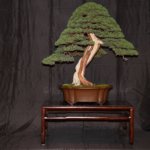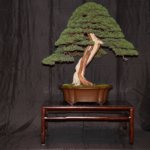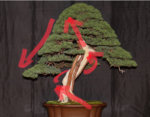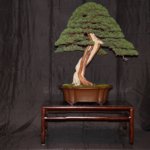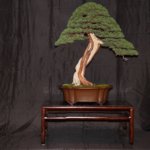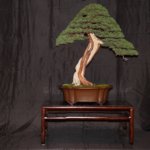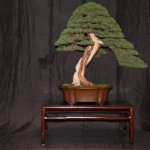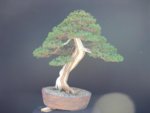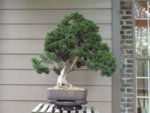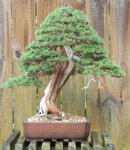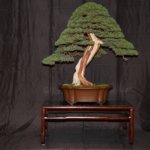I feel this is extremely important because we have two followers of one following saying the same thing, and the owner saying something different and I think some context is valuable here. I will post this and go back into the bunker.
I mentioned Kathy Shaner, whom I respect probably the most of all the professionals I have ever worked with. This tree was entered into the Kazari in Hanford California in 2010 by Boon Manikitivipart. It too is a boomerang shaped trunk with the apex centered over the root base like BVF's.
This was her opinion on boomerang shaped trunks and movement:
Boon's pine.
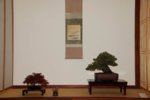
At first look this is a no brainer. The trunk points left and the primary branch is on the left this tree points left. After the Kazari was done Kathy agreed to walk around with each contestant and critique each display. Lat me also say that I won second place this year which also added to the drama because there were some magnificent trees on display and my tree was not near close to the caliber of some of the trees. This was Peter Tea's display and a magnificent juniper also. Looks alot like BVF's but notice the trunk, Boomerang shaped, and the trunk exits the soil dramatically to the right, yet he displayed it to the left. So what does Peter know that Boon doesn't?
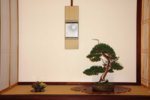
So Kathy went on to explain, much to the chagren of Jim Gremel who fought the good fight on behalf of Boon to no avail.
Kathy says: when a trunk exits the soil and moves off in a direction, and the apex follows and ends away from the root ball, it is considered a slanting tree. If the trunk turns back, in a boomerang shape and the apex lands over the root mass, it is a Moyogi tree, If the tree's foliage and branch structure is primarily built within the confines of the top of the boomerang, it can be considered the
living movement of the tree.
Now, Jim Gremel argued, that if a small man, (you had to be there, I've never seen slow easy going Jim get so animated, I was cracking up) came in and sawed that pine down, which way would it fall? Easy, it would fall to the left, the way he has the tree pointed. But Kathy explained to Jim that the living portion of the tree is well above the central bend in the trunk and points right, and so does the apex.
It ended with I'm sorry Jim, I'm the judge and you don't get to win this one today. Jim hung his head and walked away.
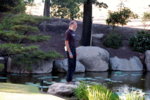
So there you have it. That is why I said what I did. That is what a Professional from Japan in a very prestigious jury judged bonsai competition had to say. I made 1000.00 bucks that day with a so so tree and a stand I built. I was happy as a clam to be within all that company and place, because I did my homework on what TOKO KAZARI is, not SEKI KAZARI which is what Boon did.
You guys have a great day, and the idea here is not etched in stone, this is just one professionals idea of how to determine movement.
